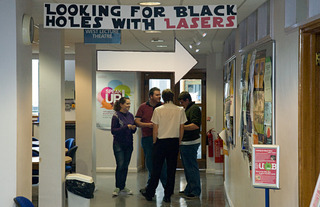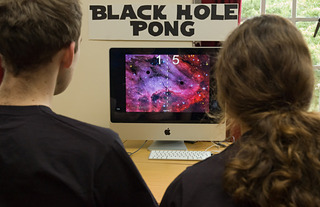Looking for Black Holes with Lasers
An exhibition by the Birmingham Gravitational Wave Group
at the British Science Festival,
the University of Birmingham, 16.-18. September 2010
In September 2010 the British Science Festival came to Birmingham! As part of the national celebration of all that is science, we put together an exhibition entitled 'Looking for Black Holes with Lasers'. Black holes are very difficult to see directly, but if two black holes collide they send waves through the fabric of our universe, strong enough to be detected many galaxies away. Our research work is dedicated to the understanding and observation of these `gravitational waves'.
The exhibition was centered around a set of interactive computer games and hands-on demonstration models of gravitational wave detector technology; three public talks completed the program. Over 250 visitors joined us during the three days of the exhibition to find out how we use lasers to discover black holes by observing the gravitational radiation that they emit.

|

|
We had dedicated the summer of 2010 to the development of new outreach material, from T-Shirts and badges to computer games and complex hands-on demonstrators. With the help of all members of the Birmingham Gravitational Wave Group we could combine everything for the first time under the banner of `Looking for Black Holes with Lasers'. We further received help from our GEO 600 partners, especially Glasgow and Milde Marketing, who provided us with advice and material from previous exhibitions.
We had three very exciting and also very exhausting days during exhibition. But it was worth it! The good attendance and very positive feedback marked an excellent start for our newly developed outreach material! Below you will find brief descriptions of the games and models we used, all of which can be available for other events and exhibitions. For more information about our outreach displays, please contact us.
Interactive Games
We have
developed a number of interactive games to be used at science exhibition and
events. Some of these
debuted very successfully at the British Science Festival 2010. A
brief description of these game is given below; our games are
also available for download at our
processing pages at .org.
Space Time Quest

Have you ever wondered what it would be like to be in charge of a budget of £100 Million!? Have you ever wondered what it would be like to be the principal investigator on a continent spanning science project, with the aim of making one of the most important discoveries of the last 50 years!? Well here is your chance to use your scientific skills to build the most sensitive gravitational wave detector ever, and use it to listen to the symphony of the universe as never before!

Space Time Quest is a manager-sim style game, where the player has to
design a gravitational wave detector.
As well as hopefully being a fun and competitive game for people to
take part in, Space-Time Quest also has educational merits for
the user, especially when used in conjunction with the
gravitational
waves E-book. By playing the game, the user should learn about
the complexity of gravitational wave detectors and about the
new technologies involved.
You can soon download the game itself, see a trailer and find more information on our Space Time Quest page at .org.
Black Hole Pong

A light-hearted remake of the old classic, now with a cosmic twist!
The original game of Pong involved each player controlling a paddle
which they would use to bounce a ball back to their opponent, in the
hope they would miss. Each time the ball touched the opponent's side
of the screen, the player would win a point. In this remake, each
player now controls a black hole! The objective; to position their
black hole on their side of the screen and utilise its gravitational
potential to fling an approaching star back. Whoever lets a star slip
past loses!

The main attractions of the game are its good looking graphics, the fun sound effects and the fact that it can be played with Xbox controllers. It looks and feels like a proper arcade game! The educational aspect is well hidden and comes as a learn-as-you-do effect: this game requires some understanding of how gravitational potentials behave. Each black hole has an attractive force on the star which decays with seperation distance. Now you need to employ that attractive force to bounce the start back to where it came from!
You can download the game itself, see a trailer and find more information on our Black Hole Pong page at .org.
A Virtual Mirror

This computer program creates a virtual mirror with the computer screen and a web camera. A face detcetion algorithm is used to display a hovering question mark over people's faces. The virtual mirror can be used simply as a fun element or, for example, be shown on a large screen in the entrance area of an exhibition or a particular room in order to make people stop and take a closer look.

During our exhibition we could see that especially children started to play with the
application: by drawing smiley faces on paper or covering parts of
their faces they started to test the face detection algorithm.
You can download the source code of this application on the
You Are
Einstein
page at .org.
Stretch and Squash

This application shows how a passing gravitational wave would stretch and squash the distances between objects. This effect is shown visually exaggerated by stretching and squashing an image of a ring of `test masses', an interferometer, or the video output of a web camera. The latter one can be very useful, for example, to stretch and squash your audience for a while during a public talk.
Gravitational waves come in two distinct polarisations, called `plus' and `cross'. Similarly to light fields these polarisations describe the direction of the wave's oscillation perpendicular to the direction of propagation. `Plus' and `cross' polarisations can also be combined to create more complicated patterns such as elliptical or circular polarisations. This application illustrates the different effects that gravitational waves in different polarisations would have on space.
You can download this application and also see a short video of the program on the
Stretch
and Squash
page at .org.
Hands-on Models
In addition to the computer games we have provided a few hands-on
models to demonstrate technologies or concepts related to
gravitational waves and gravitational wave detectors.
Fabric of the Universe

One of the most successful and yet easiest to make hands-on object is this model to illustrate Einstein's idea of gravity as a curvature in space-time. In Einstein's theory of general relativity gravity is not a force but geometry. Mass (and energy) warps space and time. In turn, the geometry of space and time determines how objects move. This is the modern interpretation of the `gravitational force'.
The model is easy to make: take on sheet of stretchy
stuff (usually rubber, or latex, in our case Lycra), stretch it over
a frame (typically square but circular works better) and decorate
it with a grid. Place a heavy metal ball in the center to serve
as the massive body (Earth, Sun, black hole). Then provide smaller
balls (table-football balls work well) to the audience and let
them start the balls to see them `orbiting' around the massive
center object.

This is an easy and fast activity. Most people simply enjoy launching
the balls in new directions, with new speeds, trying to make them
collide or remain the longest time away from the center.
The deformation of the grid provides a good visual aid to describe how the massive object distorts the space (and time) around it. By following the movements of the smaller balls it is possible to visualise how the center mass builds an attractive force (or potential) through curving the elastic space-time model.
Michelson Interferometer

Modern gravitational wave detectors are laser interferometers,
whose optical setup is based on the principle of the Michelson
interferometer invented more than 100 years ago.
Our small model of a Michelson interferometer is a reclaimed piece of equipment from a first-year student laboratory in Birmingham. Mirror number 4 in the setup can be moved by turning a micrometer wheel. This motion will change the light detected by the photo diode. The signal from the photo diode is then amplified and fed into a loudspeaker so that a one can hear how the interferometer behaves. The rate at which the light changes is the frequency of the emitted sound.
Mirror Suspension System

The mirrors used in gravitational wave detectors must be very, very
quiet so that the tiny effects of a passing gravitational wave are
not masked by unwanted mirror motion. In order to achieve this, the mirrors
are suspended from a sophisticated vibration isolation system.
Our group has build and delivered electronic components for
the mirror suspension system of Advanced Ligo.
This was reason enough for us to build an operational model of a gravitational
wave detector mirror suspension system including the Birmingham designed
and manufactured `BOSEM' sensor/actuator system.
The stand shows the actual readout and control electronics, that
will be used in the Advanced LIGO detectors.